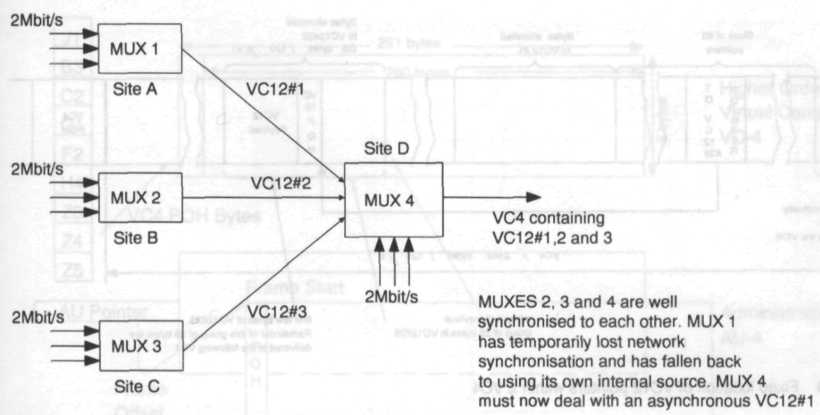
- •42 The Synchronous Digital Hierarchy (sdh)
- •42.1 Introduction
- •42.2 Pdh deficiencies
- •42.3 The basis of sdh
- •42.3.1 The concept of pointers
- •42.4 The sdh standards
- •42.4.1 Path OverHead information
- •42.4.2 Multiplexing of Virtual Containers
- •42.4.3 Channels and Tributary Unit Groups
- •42.4.4 Vc4 Into a Synchronous Transport Module
- •42.4.5 Further use of Pointers
- •42.4.6 Other sizes of vCs and payloads
- •42.4.7 Sonet and sdh
- •42.4.8 Nni Optical Interface standardisation
- •42.4.9 Sdh network elements
- •42.5 Control and management
- •42.6 Sdh based networks
- •42.6.1 Sdh network topologies
- •42.6.2 Deployment strategies
- •42.7 Impact of broadband standards
- •42.7.1 Frame Relay
- •42.7.2 Switched Multimegabit Data Service (smds)
- •42.7.3 Fibre Distributed Data Interface (fddi)
- •42.8 Future technologies
- •42.8.1 Integrated circuits
- •42.8.2 Optical interfaces
- •42.8.3 Optical amplifiers
- •42.8.4 Optical switching
- •42.8.5 Memory and processing power
- •42.9 Conclusion
42.4 The sdh standards
There are now a dozen or more CCITT recommendations describing various aspects of SDH, but the centre-piece of the whole group is undoubtedly CCITT G.707/8/9. These three standards define the SDH multiplexing structure and the ways that non SDH traffic channels can be mapped into the SDH Virtual Containers. Other standards in the group deal with such things as the functionality of multiplexers (G.781/2/3), the management requirements of such equipment (G.784), and the equivalent recommendations for line systems (G.958). Optical interfaces for all types of SDH equipment are covered in G.957. Further standards (G.sdxcl/2/3, still in the draft stages) address the functionality of synchronous cross connects. Finally there are two more standards (G.snal/2), which address the way that entire SDH based networks should be constructed in order that they can interwork successfully with other such networks and, even more importantly, so that the management of these networks can be brought under software control. Nevertheless, because of their central role in SDH, we shall concentrate mainly on explaining G.707/8 & 9.
Bearing in mind the nesting of smaller VCs within larger ones, and thence into STMs, the best way to appreciate the details of the SDH multiplexing standards G707/8/9, is to follow the progress of a hi-directional 2Mbit/s plesiochronous circuit, which, for part of its journey, is transported across an SDH based network. (See Figure 42.8.) Such a 2Mbit/s circuit could be a channel between two PSTN switches, or it could be a private leased line which is connecting two PBXs. Although the 2Mbit/s circuit is bi-directional, the SDH operations are identical in both directions, hence we shall concentrate on just one direction of transmission, that from A to D.
At point B, where the 2Mbit/s circuit meets the SDH network, the first operation is to take the incoming plesiochronous hit stream and selectively add 'stuffing' bits in order to 'pad-out' this hit stream to the exact rate required to till the appropriate Synchronous Container. In this case, the Synchronous Container size would be a C12, which is sufficiently large to accommodate a 2Mbit/s plesiochronous bit stream at the limits of its 50 ppm tolerance, together with some additional 'fixed stuffing' bytes. The stuffing of the plesiochronous bit stream should ideally be done relative to the clock to which the whole SDH network is beating, however, as discussed in Section 42.3, there is a chance that the SDH network element (e.g. multiplexer) which is performing the stuffing operation, is not quite synchronous with the rest of the network. In this case C12 which it creates is similarly asynchronous.

Figure 42.8 2Mbit/s plesiochronous circuit from A to D, which is transported by an SDH network for part of its journey

Figure 42.9 Synchronous multiplexing of VC12s into a VC4 when VC12s are created in various places
42.4.1 Path OverHead information
Having mapped the 2Mbil/s bit stream into the C12, the next operation is to generate and attach the Path Overhead byte (POH), which enables this C12 to be identified, monitored for errors and routed through the SDH network. The addition of this POH byte to the C12 creates a Virtual Container 12 (VC12). As mentioned in Section 42.3, the idea is that the POH stays attached to its C12 all the way from the point where it was generated, to the point at which the 2Mbit/s payload exits the SDH network. These two points are the 'Path Termination' points for this VCI2, with the continuous stream of VCs between them being referred to as the Path. Between the two path termination points at B and C, there is no legitimate mechanism for altering any of the information in the POH, hence if the receiving path termination detects any discrepancy between the POH and the content of the VC12 payload (i.e. the C12), this indicates that the VC12 payload has somehow become corrupted during its journey across the SDH network. Although path level monitoring is sufficient for a PTO to ascertain what error rate is being inflicted by the SDH network on his customers' 2Mbil/s circuit, it provides no information whatsoever on the source of the errors i.e. which network element has gone faulty. This task is dealt with by the addition of still further overhead information, which will he described shortly. Before this, it is necessary to examine the way in which several VC12s are multiplexed into a higher rate signal.
